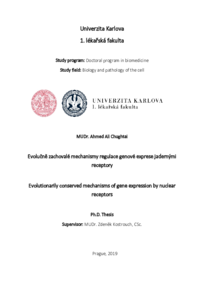Evolutionarily conserved mechanisms of gene expression regulation by nuclear receptors.
Evolučně zachovalé mechanismy regulace genové exprese jadernými receptory.
dizertační práce (OBHÁJENO)

Zobrazit/
Trvalý odkaz
http://hdl.handle.net/20.500.11956/115578Identifikátory
SIS: 147778
Kolekce
- Kvalifikační práce [4306]
Autor
Vedoucí práce
Oponent práce
Malínský, Jan
Brábek, Jan
Fakulta / součást
1. lékařská fakulta
Obor
-
Katedra / ústav / klinika
BIOCEV, 1. LF UK
Datum obhajoby
28. 11. 2019
Nakladatel
Univerzita Karlova, 1. lékařská fakultaJazyk
Angličtina
Známka
Prospěl/a
Klíčová slova (česky)
Jaderné receptory, metabolismus lipidů, Komplex mediátorů, MED28, Perilipin, Trichoplax adhaerens, Caenorhabditis elegans, RXRKlíčová slova (anglicky)
Nuclear receptors, Lipid metabolism, Mediator complex, MED28, Perilipin, Trichoplax adhaerens, Caenorhabditis elegans, RXRTranskripční regulace genové exprese eukaryotních organismů se vyvinula během milionů let. Regulační cesta jaderných receptorů představuje evolučně starý, ale zachovalý mechanismus zahrnující asociované akcesorní proteiny, z nichž mnohé tvoří funkční strukturu známou jako Mediátorový komplex, který je účastný v transkripci. Hypotézujeme, že přes universalitu této cesty, v níž vnitřní potenciál NR-Mediátorové cesty zachovalý napříč druhy, přímo překládá regulační signál do biologické odpovědi zapojením nových adaptačních funkcí ve fylogeneticky novějších Metazoidních organizmech a přídavná regulace může být dosažena sekundárními funkcemi základních členů této regulace. Pro podporu této hypotézy jsme studovali schopnost vazby ligandu retinoidního X receptoru ve vločkovci Trichoplax adhaerens a přinesli důkaz podporující koncept, že tato schopnost byla přítomna již na počátku metazoidní evoluce. S ohledem na možné sekundární funkce, majíce inspiraci z našeho předcházejícího výzkumu, jsme identifikovali Mediátorovou podjednotku 28 (MED28) jako jediný známý člen s dokumentovanou duální cytoplasmatickou a jadernou funkcí a mající tedy potenciál přenášet signály z jaderných strukturních stavů do jádra. V důsledku chybění významné zachovalosti sekvence, ale dostupnosti experimentálních přístupů, jsme se...
Transcriptional regulation of gene expression in eukaryotes has evolved over millions of years. The regulatory pathways of nuclear receptors represent an evolutionarily ancient, but conserved mechanism with associated accessory proteins, many of them forming a functional nexus known as the Mediator complex involved in transcription. Despite the versatility of the pathway, e.g. through the adoption of new regulatory functions in phylogenetically more recent Metazoa, we hypothesise that the intrinsic potential of the NR-Mediator axis to directly translate a stimulus to a biological response is conserved across species, and additional regulation could also be achieved through secondary functions of its essential members. To support the hypothesis, we assessed the ligand-binding capability of retinoic X receptor in Trichoplax adhaerens and provided evidence to support the concept that this capability was already present at the base of metazoan evolution. With regards to the potential secondary functions, we took inspiration from previous research and identified the Mediator subunit 28 (MED28) as the only known member having documented nuclear and cytoplasmic dual roles, and thus possessing the potential to transmit signals from the cellular structural states to the nucleus. Due to the lack of...
